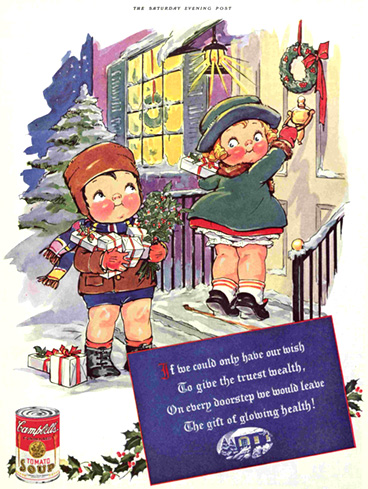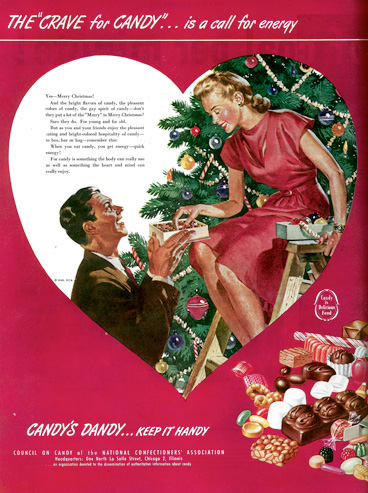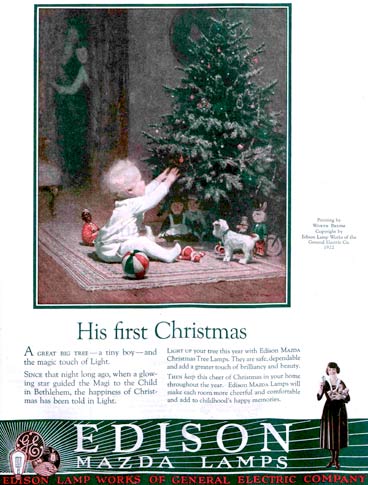From an Edison Phonograph in 1909 to a new Plymouth in 1951 (ad by Norman Rockwell!), we’ve found decades of great Christmas ads from a bygone era.
Edison Phonograph

Edison Phonograph advertisement
December 11, 1909
In 1877, a machine that could record and play sound back was a fantasy. Thomas Edison developed the phonograph and gave a detailed sketch to his mechanic to build. What happened next changed the world. “Edison immediately tested the machine by speaking the nursery rhyme into the mouthpiece, ‘Mary Had a Little Lamb.’ To his amazement, the machine played his words back to him.” It had to be a magical moment.
The phonograph manufacturer was well aware that the purchase was a major expense. This 1909 ad suggested that “if every member of the family would take the money he or she expects to use to buy presents for the other members of the family, and put it together, there will be enough not only to buy an Edison Phonograph, but also a large supply of Records.” This was perhaps optimistic. Despite Edison’s desire to see “a phonograph in every home,” the machine cost $12.50 to $200.00 (equivalent to between $300 and $5,000 today).
Interwoven Socks

Interwoven Socks advertisement
J.C. Leyendecker
December 17, 1921
“Get him a box for Christmas” says this 1921 ad for Interwoven Socks, a major contract for J.C. Leyendecker. Considered by many the 20th century’s greatest illustrator (he was Norman Rockwell’s mentor), the prolific Leyendecker kept up an almost frenetic pace. He was The Saturday Evening Post’s most prolific cover artist, with 322 covers between 1899 and 1943. For decades, he was as well known for his stunning advertising art as for his covers for The Saturday Evening Post and several other publications. His handsome Arrow Collar man was masculine ideal for more than 30 years. And of course, he drew what would become a timeless St. Nick for Post covers and ad work alike.
Campbell’s Soup

Campbell’s Soup advertisement
Grace Drayton
December 24, 1932
The Campbell’s Soup Kids came about almost by accident. In 1904, Grace Drayton’s husband, an advertising man, had an appointment with the Joseph Campbell Company. He asked Grace to add a few characters to his advertising copy that might work for Campbell’s soup. A children’s illustrator, she drew her typical tots with rosy cheeks, dimpled knees and all. Campbell’s loved the little cuties and, at a time when women weren’t encouraged to have careers, a career was born.
The kids went from magazine ads beginning in 1905 to radio in the 1930s to television in the 1950s. Merchandising also began in the 1930s and even today, an unbelievable amount of merchandise, from dolls to mugs and so forth, is available bearing the chubby-cheeked images. This 1932 ad shows the cherubs in full Christmas spirit with the poem:
If we could only have our wish
To give the truest wealth,
On every doorstep we would leave
The gift of glowing health!
Candy

National Confectioners’ Association Candy advertisement
December 21, 1946
From 1946 comes this ad promising what we all need during the holiday season: quick energy. It further notes that “candy is something the body can really use as well as something the heart and mind can really enjoy,” which is somewhat more eloquent than the slogan at the bottom: “Candy’s Dandy … Keep It Handy.” The ad was placed by The National Confectioners’ Association, an organization founded in Chicago in 1884 and which, yes, is still around today.
Cream of Wheat

Cream of Wheat advertisement
Edward V. Brewer
December 6, 1922
American artist Edward V. Brewer (1883-1971) created distinctive advertising art for Cream of Wheat cereal. The iconic chef would appear in each ad, perhaps front and center and at times, as in this 1922 ad, more obscurely placed (in this case, in the newspaper on the floor). There are divergent views on the depiction of the chef: some see it as racist, a sort of Uncle Tom character; others see the chef as kind and trustworthy. This was a different era, after all, and we present it here as part of America’s cultural history. Because of their historical significance, and the quality of the artwork, the old Cream of Wheat ads are highly collectible today and originals often fetch between $7,000 and $10,000.
Rockwell Plymouth

Chrysler Plymouth advertisement
Norman Rockwell
December 22, 1951
We don’t need a picture of a gleaming new car, nor copy details about hydraulics, torque, or ease of handling. The simple text: “Oh, Boy! It’s Pop with a new PLYMOUTH!” and the faces of the family are enough. And it doesn’t hurt that the illustration is by Norman Rockwell. Yes, along with iconic covers for The Saturday Evening Post, America’s favorite artist sold everything from socks to mouthwash, as we’ve seen in “Norman Rockwell, Ad Man.” The Plymouth ad is from 1951.
Chrysler Plymouth

Edison Mazda Lamps advertisement
Worth Brehm
December 9, 1922
Click this image for a close-up and you’ll observe the family peeking from the doorway at the classic toys, such as Raggedy Ann and Andy. Post cover artist Worth Brehm created this illustration for Edison Mazda Lamps. Another artist who did quite a few ads for Edison was Norman Rockwell.
Become a Saturday Evening Post member and enjoy unlimited access. Subscribe now




Comments
These ads are indeed fine art as Chuck mentioned. I have my doubts many at all will be because they’re all loud “hard sell” ads devoid of any charm or humanity, not to mention they’re electronic media fleeting, disposable images.
I like Alice’s comment too, and do agree. I wish that America were still around, but too much has happened too quickly in the last five decades with beauty, simplicity and caring being among the victims. There are still good people doing good things though, there are, even if it’s less common now.
these pictures are wonderful parts of ourselves.memories of what america is made from.beauty simplicity caring strength all that matters.thank you so much ive enjoyed
It was fun seeing the ads from over 60 years ago. They are now fine art, I wonder if ads from today will be?